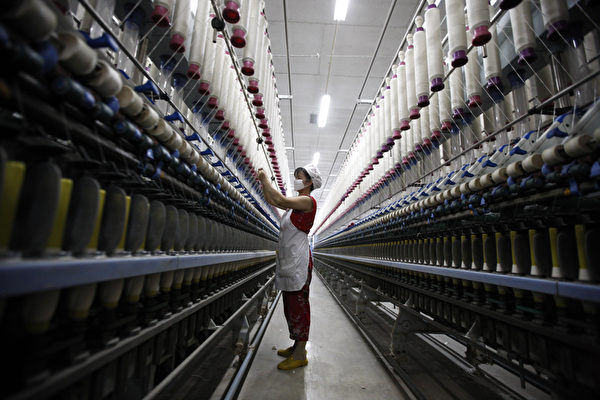[Epoch Times, February 26, 2022]Guangzhou is the center of China’s textile and clothing export industry, which once attracted a large number of people to work there. But after the new year, with the economic slowdown and U.S. sanctions on Xinjiang cotton, the former large number of job opportunities no longer exist.
Guangzhou is an important textile trading center in China, and the prestigious Zhongda Cloth Market has become the largest cloth wholesale center in Guangzhou after more than 20 years of development. The textiles and clothing produced in Guangzhou’s “Textile Village” are eventually sold overseas, thus attracting many workers to work in Guangzhou. Especially after the New Year every year, many companies form teams in industrial areas or on the roadside to recruit employees with sample clothes. The daily salary can reach more than 600 yuan. The phenomenon of “employees picking companies” often occurs.
However, after the New Year this year, China’s self-media “International Textile Trends”, which is concerned with the textile industry, visited some clothing trading distribution centers in Guangzhou, including Datang Village, Houjiao Village, Ruibao Village, etc., but found that the appearance of “employees picking companies” was different. Furthermore, there is a huge flow of job seekers, and a large number of workers are looking for recruiting companies everywhere.
A worker from Jiangxi told the self-media that the market was very cold after the New Year. He himself had come to Guangzhou on the sixth day of the lunar new year (February 6th), and only had one shift on the 15th. He thought he had a lot of orders to do, but finally “Everyone made two packs of goods, and then there was no goods to make, and they got off work early.”
Another worker said that the owner of the factory is still in Zhejiang, and the factory has not yet opened, so foreign orders should not have been placed so quickly. He also said that even the Zhongda Supplementary Materials City only started construction on the 13th of the year (February 13).
Some textile factory owners pointed out that there were no orders at the beginning of the year, even if they started to work on some stockpiles last year, coupled with the epidemic, they bluntly said that the clothing industry is under pressure this year.
It is worth noting that the United States banned the import of products involving forced labor from Xinjiang last year. According to Urumqi customs data, from January to October 2021, the export value of textile yarns, fabrics and products at Xinjiang ports was 3.104 billion yuan, a year-on-year decrease of 31.84%.
Industry insiders: The epidemic and economic contraction have affected the textile industry
Mr. Li, a businessman familiar with China’s textile industry, told this station that the epidemic will affect the textile industry more or less, but the main reason is that it is related to China’s domestic economic contraction.
Mr. Li: “At a deeper level, I think it’s a system problem. Now the relationship between the government and other countries is not well handled, and foreign trade has been greatly reduced. The rapid development of China’s economy is mainly driven by foreign trade, which accounts for a large proportion. Due to insufficient domestic demand, If foreign trade shrinks, where will the production go? Who will it be sold to?”
China’s “Economic Daily” reported last month that textile exports continued to grow in December last year, but it is estimated that the textile and garment foreign trade will face more unstable factors in 2022. The report mentioned that the living conditions of small and medium-sized textile and garment foreign trade enterprises are also facing some problems, such as lack of cores, cabinets, labor, freight, raw material costs, energy and resource prices, exchange rate fluctuations, etc. It is estimated that many textile and garment foreign trade enterprises Profit margins have been compressed, and they generally face the practical dilemma of “increasing revenue without increasing profits”.
Financial people: The real estate crisis has caused problems in other industries
Financial commentator Bi Xin analyzed to this station that China’s economic problems began with real estate, and the government hoped to guide financial institutions to abandon real estate and turn to textiles or other industries. In this game between financial institutions and the government, other industries have also experienced “liquidity decline” and “structural imbalance” economic problems.
Bi Xin: “Real estate is the root cause of China’s biggest economic crisis. The main problem is in the game between financial institutions and the government. The government wants financial institutions to put down real estate and turn to other directions, but there are too many non-performing assets that have not been dealt with. It is clear that financial institutions definitely don’t want to let go, so they will have a big game. In addition, how can the government guide financial institutions to better invest in the textile industry or other industries?”
According to China Customs data, China’s textile and apparel export trade volume will be US$315.47 billion in 2021, a year-on-year increase of 8.4%, of which the top five export markets are the United States, ASEAN, the European Union, Japan and South Korea. In addition, from the perspective of the top 5 provinces and cities in China’s exports, Zhejiang, Jiangsu, Shandong and Fujian’s export growth rate of textile and clothing exceeded the national average, but the export of Guangdong Province was negative.
From Radio Free Asia
Responsible editor: Liu Yi
